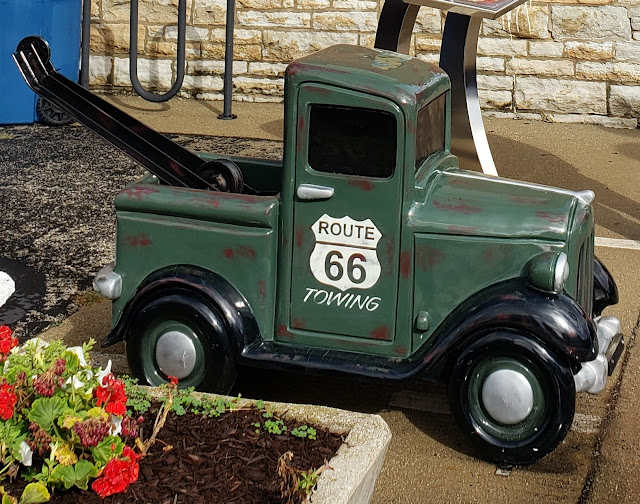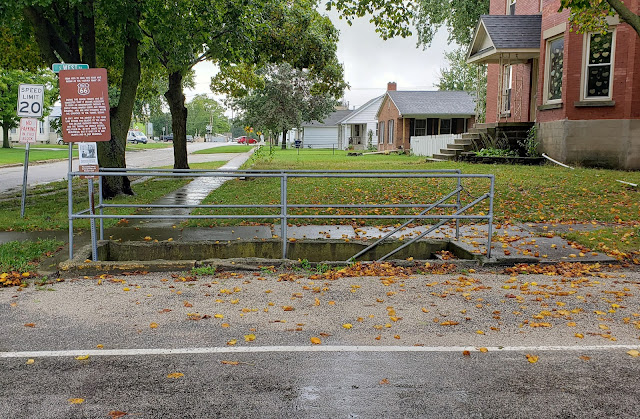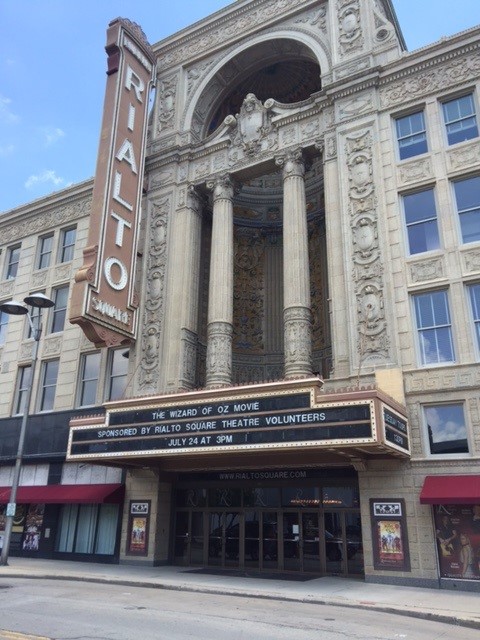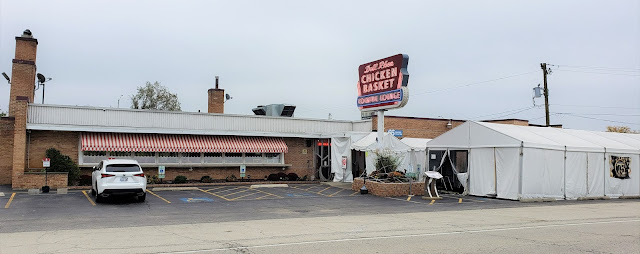We loved our visit to Pontiac, Illinois . It’s a great example of those towns along Route 66 that have truly embraced their Route 66 heritage and transformed themselves into a special, worthwhile stop for today’s Route 66 roadtrippers.
About a mile before Pontiac, we turned left on N 1600 E Road, then immediately forked right onto E 1830 N Road (described as Pontiac Road in some resources). As soon as we turned off the Route 66 bypass, we saw the 1926 Old Log Cabin Inn & Restaurant.
 |
| Old Log Cabin Inn & Restaurant (from OnlyInYourState.com) |
I read that, when the Route 66 bypass around Pontiac was built, the building was lifted and turned so it faced the new highway.
To take the 1926 “alignment” of Route 66 into Pontiac, curve left onto North Division Street, then curve right onto North Lincoln Avenue, then fork right onto North Ladd Street. Turn left (east) off this 1926 alignment at West Howard Street to get to Pontiac’s downtown.
Our first stop was the Illinois Route 66 Hall of Fame & Museum at 110 West Howard Street.
 |
| Illinois Route 66 Hall of Fame & Museum in Pontiac |
We parked on a street behind the museum and immediately saw several of the murals for which Pontiac is famous.
 |
| A great photo op on the back wall of the Illinois Route 66 Museum |
 |
| This delightful mural advertises Lipton Tea. |
 |
| This mural advertises the Bloomington, Pontiac, & Joliet streetcar. |
 |
| Not a row of shops, just a mural that looks like one! |
The museum, in a former firehouse, includes a visitors
center with friendly, helpful staff, a map of all the town’s 23 murals, and brochures of other Pontiac attractions. The museum is mostly a
collection of Illinois Route 66 memorabilia, arranged by location from north to
south. In the same building, on an upper floor, is the Livingston County War
Museum.
Pontiac is very walkable—most of the things we wanted to see were within walking distance. The sidewalks have painted footprints to guide you to the murals and museums.
A block south of the Route 66 museum is Livingston County Courthouse, built in 1875 and one of the most colorful courthouses we’ve ever seen.
 |
| Livingston County Courthouse in Pontiac, Illinois (from VisitPontiac.org) |
Along the streets near the courthouse are shops and cafes. Just west of the Courthouse is Pontiac-Oakland Auto Museum, which we didn’t have time to visit. Instead, we walked south to East Water Street, then east to South Riverview Drive. Along the way, we saw some of the adorable small vehicles scattered around downtown Pontiac sidewalks.
 |
| One of the little cars around downtown Pontiac |
 |
| A little tow truck behind the Illinois Route 66 Museum |
Two blocks south of East Water Street, just off South Riverview Drive, is one of Pontiac’s two swinging footbridges over the Vermilion River.
 |
| 1898 swinging footbridge in Pontiac, Illinois |
 |
| Another view of Pontiac's 1898 swinging footbridge |
We crossed the one first built in 1898; the other one was first built in 1926. The footbridges were built for workers living on the south side of Pontiac to commute to shoe factories on the north side. To be honest, they don’t really swing—they just bounce a bit as you walk on them.
Some of the streets in this section of Pontiac are paved in brick.
 |
| Some of the brick streets in Pontiac, Illinois |
We drove out of Pontiac on Mill Street (IL 10) so we could see two more murals. Southbound travelers like us see a mural about the Vermillon River.
 |
| Vermilion River mural (from VisitPontiac.org) |
The reverse side of the billboard welcomes northbound travelers to downtown Pontiac.
 |
| Downtown Pontiac mural (from VisitPontiac.org) |
From Mill Street, we turned right (west) on West Reynolds Street to get back to the Route 66 bypass.
About 2 miles south of Pontiac, we saw one more gem: the former Illinois State Police Building, built in 1941 in art moderne style, with features like curves and glass bricks.
 |
| Former Illlinois State Police Building (from nps.gov) |
It’s listed on the National Register of Historic Places but is now sadly abandoned.

































